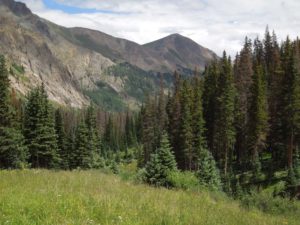This story is based on a news release developed by The Nature Conservancy.

Preserving, restoring and improving the United States’ lands and coastal wetlands could have a much bigger role in reducing global warming than previously thought. That’s according to the most comprehensive national assessment to date of how greenhouse gas emissions can be reduced and stored in forests, farmland, grasslands and wetlands.
The study, led by scientists from The Nature Conservancy, Colorado State University and 20 institutional partners, found that protecting and restoring natural lands could offset 21 percent of the nation’s current net annual emissions. These changes could occur by adjusting natural management practices to increase carbon storage and avoid greenhouse emissions.
The study, “Natural climate solutions for the United States,” was published Nov. 14 in Science Advances. It is the first to include the climate benefits of coastal wetlands and grasslands in a comprehensive mix, along with forests and agriculture.
Researchers identified potentially large impacts in the management of forests, said co-author Rich Conant, a professor in the Department of Ecosystem Science and Sustainability , associate dean in the Warner College of Natural Resources and a member of the Natural Resource Ecology Laboratory.
“Our research found that we already have negative emission technologies in the form of natural climate solutions that are readily available,” he said. “These solutions are also cost-effective, and could offer the United States a powerful tool to address a warming planet.”
The recommendations are timely, given that in October 2018, the Intergovernmental Panel on Climate Change special report called for immediate global action to limit warming to 1.5 degrees centigrade (approximately 3 degrees Fahrenheit), to avoid the most damaging climate change impacts.
This new study highlights how, and which, natural solutions in the United States offer the most promise to help limit temperatures below that 3 degrees Fahrenheit goal.
Planting trees, increasing controlled burns
Of the 21 natural solutions analyzed by the team, planting trees emerged as the largest means to achieve greater carbon storage, equivalent to eliminating the emissions of 65 million passenger cars. Other high-performing forest solutions include allowing longer periods between timber harvest to increase carbon storage; increasing controlled burns and strategic thinning in forests to reduce the risk of megafire; and avoided loss of forests from urban sprawl.

The study identified as much as 156 million acres in the U.S. that could be reforested, 304 million acres where forest harvest rotations could be extended, and at least 42 million additional acres of forests that would benefit from fire risk reduction treatments. In addition, almost a million acres of forest are being converted to non-forest habitat a year, largely due to suburban and exurban expansion, which could be addressed through better land use planning. Urban reforestation could add important carbon storage benefits, the research team said.
Joe Fargione, director of science for The Nature Conservancy and the study’s lead author, noted that one of America’s greatest assets is its land.
“Through changes in management, along with protecting and restoring natural lands, we demonstrated we could reduce carbon pollution and filter water, enhance fish and wildlife habitat, and have better soil health to grow our food — all at the same time,” he said. “Nature offers us a simple, cost-effective way to help fight global warming. In combination with transitioning to zero carbon energy production, natural climate solutions can help protect our climate for future generations.”
Other solutions in grasslands, under water
Grasslands are underappreciated for their carbon storage opportunity, according to the researchers. Grassland is being lost at a rate of over one million acres per year. When grassland is converted to cropland, about one-third of the carbon in the top meter of soil is released to the atmosphere. This trend could be reversed by re-enrolling 13 million acres of marginal cropland in conservation programs and restoring them to provide habitat and storage of carbon in the soil.
Existing croplands also have an important role to play, according to the study. Farmers can optimize their nutrient application, saving money and avoiding emissions of nitrous oxide, a potent greenhouse gas. Farmers can also plant cover crops, which suck carbon out the atmosphere and return it to the soil during times of the year when fields would normally be bare.
Natural solutions can be found under water as well. Researchers found an estimated 27 percent of tidal wetlands have been disconnected from the ocean, increasing the release of methane. Reconnecting tidal wetlands to the ocean virtually eliminates those methane emissions, and also restores fish habitat important for coastal communities.